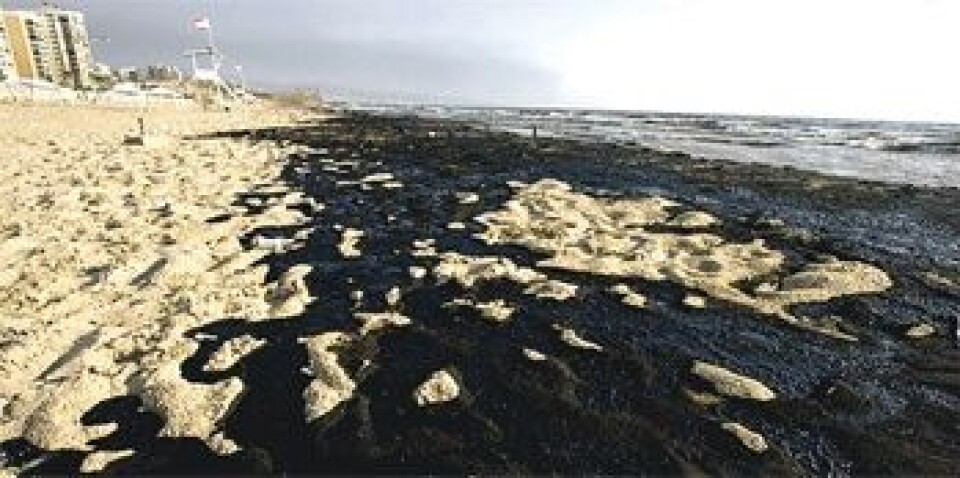
Vietnams kystlinje utsatt for mystisk oljesøl
I tre måneder er Vietnams kystlinje blitt utsatt for oljesøl med store ødeleggende virkninger uten at myndighetene klarer å finne hvor oljen stammer fra.
Denne artikkelen er tre år eller eldre.
I tre måneder er Vietnams kystlinje blitt utsatt for oljesøl med store ødeleggende virkninger uten at myndighetene klarer å finne hvor oljen stammer fra. Regjeringen ser bort fra at det kommer fra Vietnam selv, og søkelyset settes på sørlige Kina blant annet oljerigg som ble skadet av en tyfon i fjor høst. Nylig ble et anlegg for hummeroppdrett utsatt for oljen, og feriestedet Nha Trangs hvite strender har også fått merke den mystiske forurensningen.
Vi referer fra en Hanoi avis i slutten av april – kanskje er saken oppklart før dette leses:
For three months crude oil spills have sullied beaches, mangroves and aquaculture farms along Vietnam's long coastline, but the government says the source of the pollution remains a mystery.
While soldiers and volunteers have scraped over 1,600 tons of congealed oil and sand off Vietnam's shores since late January, officials remain at a loss to explain whether the oil was dumped by a tanker or leaked from a platform.
Prime Minister Nguyen Tan Dung has said that Hanoi has asked for help from its South China Sea neighbours in finding the source of the slicks, while ruling out the country's own offshore wells as the origin.
The head of the National Search and Rescue Committee, Nguyen Son Ha, has said that a possible culprit was a leaking Chinese oil rig south of Hainan island that was damaged in a typhoon last year.
As the world marked Earth Day, the mystery continued while the oil kept coming, threatening marine life and impacting coastal communities that rely on tourism, fishing, and shrimp and clam farms.
Vietnam's seaside resort of Nha Trang was hit by another mystery slick, scaring tourists off its usually white beaches and hitting lobster breeders in neighbouring Ninh Thuan province.
The government has released no estimates of the economic damage to the marine sector of a country that has a 3,200-kilometre coastline, amid numerous reports of badly-hit oceanside industries.
In the Mekong Delta province of Ben Tre, clam farmers have suffered an "immediate consequence of this disaster," said Keith Symington, regional marine programme coordinator of the World Wide Fund for Nature (WWF).
The farms, which were working toward being eco-certified under a model programme with the communist government and the WWF, "are now devastated, economically and environmentally, by oil contamination," he said.
The oil slicks first blackened Vietnam's central coast in late January, hitting the famed "China Beach" – a former American military rest and recreation spot during the Vietnam war – and the seashore around the historic port of Hoi An, an UNESCO World Heritage site.
At first, many shrugged off the black blobs as one of the smaller spills that have become a regular occurrence along one of the world’s busiest shipping lanes and also a major oil and gas producing region. But officials soon realised this year was worse, as carpets of oil started washing up along an 800-kilometre stretch of coast.
Since then, the oil slicks have spread to the far southern Ca Mau peninsula and Con Dau island, a remote nature reserve famed for its turtles where volunteers mopped up nearly 40 tonnes of oily sand in mid-March.
The state-run Vietnam National Oil and Gas Group has said the oil did not match that from its own White Tiger and Dragon fields. Some experts have suggested the oil may have seeped naturally from cracks in the seafloor, or that oil from older spills may have been churned up by an oceanographic phenomenon called upwelling.
One marine environment expert, speaking on condition of anonymity, said monsoonal patterns supported the theory that some slicks had been blown from near China's Hainan island toward central Vietnam.
Still, there is hope Vietnam is edging closer to an answer. Its environment ministry asked Japan for help in detecting the source of the oil spill, a search that may include sophisticated satellite technology that Vietnam lacks.











